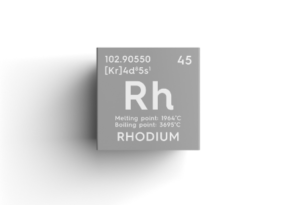 In the vast world of commodities and precious metals, few assets command the intrigue and mystique quite like rhodium. With its gleaming luster and remarkable scarcity, rhodium stands as a tantalizing prospect for investors seeking to diversify their portfolios and capitalize on the unique properties of this rare metal. But how do you invest in rhodium? Join me on a journey as we unravel the mystery and explore the pathways to investing in this elusive yet valuable asset.
In the vast world of commodities and precious metals, few assets command the intrigue and mystique quite like rhodium. With its gleaming luster and remarkable scarcity, rhodium stands as a tantalizing prospect for investors seeking to diversify their portfolios and capitalize on the unique properties of this rare metal. But how do you invest in rhodium? Join me on a journey as we unravel the mystery and explore the pathways to investing in this elusive yet valuable asset.
Rhodium: A Brief Overview
Before diving into the intricacies of rhodium investment, it’s essential to grasp the basics of this remarkable metal. Rhodium, a member of the platinum group metals (PGMs), boasts a dazzling silver-white appearance and remarkable resistance to corrosion and tarnishing. Its exceptional durability and catalytic properties make it a crucial component in various industrial applications, including catalytic converters, electronics, and jewelry.
Exploring Investment Avenues
Investing in rhodium presents a unique set of challenges and opportunities, given its scarcity and specialized industrial demand. Here are some common avenues for investing in rhodium:
1. Physical Rhodium: Acquiring physical rhodium in the form of bars or coins is one way to gain exposure to this precious metal. However, due to its scarcity and high demand from industrial users, obtaining physical rhodium can be challenging and may require purchasing from specialized dealers or bullion exchanges. Additionally, storing physical rhodium securely is essential to protect your investment.
2. Rhodium Exchange-Traded Funds (ETFs): Rhodium ETFs offer investors a convenient way to gain exposure to rhodium prices without the need for physical ownership. These funds typically hold rhodium bullion or derivatives linked to rhodium prices and trade on major stock exchanges. Investing in rhodium ETFs provides liquidity and flexibility, allowing investors to buy and sell shares with ease.
3. Rhodium Futures and Options: For more experienced investors, trading rhodium futures and options contracts on commodity exchanges can provide opportunities to profit from fluctuations in rhodium prices. Futures and options allow investors to speculate on rhodium prices without owning the physical metal, providing leverage and risk management tools for strategic trading.
4. Rhodium Mining Stocks: Investing in companies engaged in rhodium mining and production is another way to gain exposure to rhodium prices. However, rhodium mining is relatively rare compared to other precious metals like gold and silver, making rhodium mining stocks less common. Investors should conduct thorough research to identify companies with significant rhodium exposure and growth potential.
Key Considerations for Rhodium Investors
Before diving into rhodium investment, here are some essential factors to consider:
1. Market Dynamics: Rhodium prices are influenced by various factors, including industrial demand, supply constraints, macroeconomic conditions, and geopolitical developments. Investors should stay informed about market trends and developments to make informed investment decisions.
2. Risk Management: Like any investment, rhodium carries risks, including price volatility, liquidity constraints, and regulatory risks. Investors should assess their risk tolerance and consider diversification strategies to manage potential risks associated with rhodium investment.
3. Storage and Security: If investing in physical rhodium, investors must ensure secure storage to protect their investment from theft, damage, or loss. Professional storage facilities or secure vaults may be necessary to safeguard physical rhodium holdings effectively.
4. Regulatory Considerations: Investors should be aware of regulatory requirements and tax implications associated with rhodium investment, which may vary depending on the jurisdiction and the form of investment. Consulting with financial advisors or tax professionals can help navigate these regulatory considerations.
Conclusion
Investing in rhodium offers a unique opportunity to diversify investment portfolios and capitalize on the scarcity and industrial demand for this precious metal. Whether through physical rhodium, ETFs, futures, or mining stocks, investors have various avenues to gain exposure to rhodium prices and potentially profit from market fluctuations. However, rhodium investment requires careful consideration of market dynamics, risk management strategies, and regulatory considerations to navigate successfully. By understanding the nuances of rhodium investment and conducting thorough research, investors can unlock the potential benefits of adding rhodium to their investment portfolios and embark on a rewarding journey in the world of precious metals.